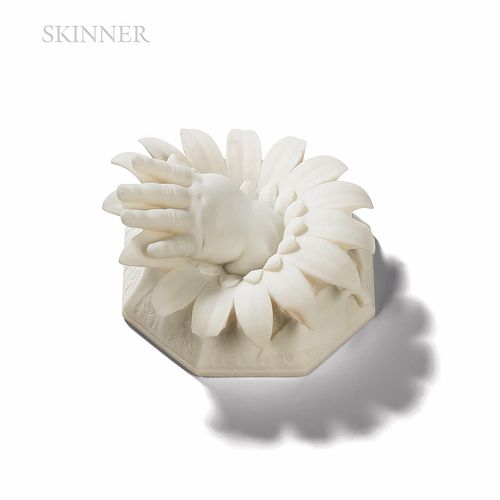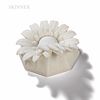Hiram Powers (American, 1805-1873) Loulie's Hand
Lot 40
About Seller
Bonhams Skinner
274 Cedar Hill Street
Marlborough, MA 01752
United States
Founded over four decades ago, Bonhams Skinner offers more than 60 auctions annually. Bonhams Skinner auctions reach an international audience and showcase the unique, rare, and beautiful in dozens of categories, including the fine and decorative arts, jewelry, modern design, musical instruments, sc...Read more
Categories
Estimate:
$10,000 - $15,000
Absentee vs Live bid
Two ways to bid:
- Leave a max absentee bid and the platform will bid on your behalf up to your maximum bid during the live auction.
- Bid live during the auction and your bids will be submitted real-time to the auctioneer.
Bid Increments
| Price | Bid Increment |
|---|---|
| $0 | $10 |
| $100 | $25 |
| $500 | $50 |
| $1,000 | $100 |
| $3,000 | $250 |
| $5,000 | $500 |
| $10,000 | $1,000 |
| $30,000 | $2,500 |
| $50,000 | $5,000 |
| $100,000 | $10,000 |
| $300,000 | $25,000 |
| $500,000 | $50,000 |
| $1,000,000 | $100,000 |
About Auction
By Bonhams Skinner
May 21, 2021
Set Reminder
2021-05-21 10:00:00
2021-05-21 10:00:00
America/New_York
Bidsquare
Bidsquare : Fine Paintings & Sculpture
https://www.bidsquare.com/auctions/skinner/fine-paintings-sculpture-6941
Join us for Paintings, Sculpture & Works on Paper on Friday, May 21, at 10AM. Participate online, over the telephone, or leave proxy bids at your convenience. This auction features select works by a diverse group of artists from the 16th century to the present. Bonhams Skinner bidsquare@bonhamsskinner.com
Join us for Paintings, Sculpture & Works on Paper on Friday, May 21, at 10AM. Participate online, over the telephone, or leave proxy bids at your convenience. This auction features select works by a diverse group of artists from the 16th century to the present. Bonhams Skinner bidsquare@bonhamsskinner.com
- Lot Description
Hiram Powers (American, 1805-1873)
Loulie's Hand
Signed "H. POWERS" along the bottom edge.
Marble, height 3 in. (7.62 cm).
Condition: Minor losses to several petals.
Provenance: Purchased from the estate of the artist Charles Gates Sheldon (1889-1960) in 1961; thence by family descent.
Literature: R.P. Wunder, Hiram Powers, Vermont Sculptor 1805-1873, vol. ii (Newark, Delaware, 1991), pp. 185-87, nos. 217-18, other examples illustrated.
N.B. Expatriate artist Hiram Powers, America's most preeminent neoclassical sculptor, is probably best known for his idealized standing nude, the Greek Slave, which was the first publicly exhibited, life-size, American sculpture depicting a fully nude female figure. After completing his first version of Greek Slave in 1844, Powers produced five full-size versions, all in marble, each slightly different. These were exhibited to great critical and popular acclaim in the late-1840s in London and across the United States. The Greek Slave challenged Victorian taboos, but in presenting the work, the artist skillfully emphasized the figure's high moral and intellectual beauty. The public also recognized its reference to contemporary political events both in Greece and in the United States.
With Loulie's Hand, we have another life-size but far more intimate work. When Powers' daughter Louisa Greenough Powers was born in 1838, the artist delighted in making many casts of her tiny hands and forearm. Powers displayed one special cast, taken when the child was one year old, in a place of honor in his studio in Florence. Using that cast, Powers created a diminutive marble sculpture of Loulie's little hand resting on a sunflower, a symbol of devotion. The resulting work became so popular that Powers' patrons requested replicas for many years. The date of the sculpture here is unknown.Condition
Any condition statement is given as a courtesy to a client, is only an opinion and should not be treated as a statement of fact. Skinner Inc. shall have no responsibility for any error or omission. The absence of a condition statement does not imply that the lot is in perfect condition or completely free from wear and tear, imperfections or the effects of aging. - Shipping Info
-
Please visit http://www.skinnerinc.com/services/payment-and-shipping/ for information regarding the collection of items purchased at auction.
-
- Buyer's Premium



 EUR
EUR CAD
CAD AUD
AUD GBP
GBP MXN
MXN HKD
HKD CNY
CNY MYR
MYR SEK
SEK SGD
SGD CHF
CHF THB
THB















